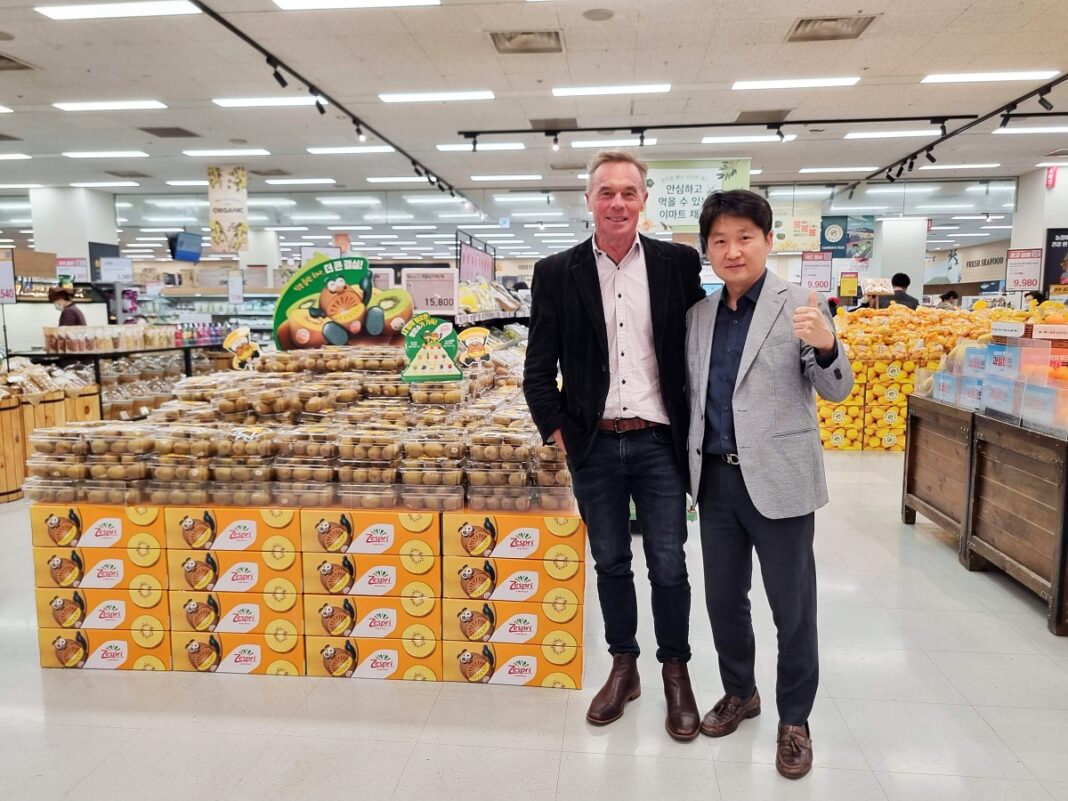The slide in crop volumes experienced in this season’s kiwifruit harvest comes as a key emerging market is enjoying double digit growth and fears it will be left short should there not be enough fruit to go around this season.
Zespri has reported a 20% slide in kiwifruit volumes for this season’s harvest, representing a loss of 35 million trays on last year’s harvest, in itself a lower yielding season.
The 136 million tray estimate marks an exceptionally low volume for the kiwifruit marketer, one not seen for at least six years and one well short of the industry’s record setting 2021 season when 182 million trays were harvested.
Zespri CEO Dan Mathieson attributed the decline to an atrocious run of weather that kicked off with less-than-ideal conditions in winter.
 A vicious late frost in early October slammed may BoP orchards, floods from Cyclone Hale washed through Coromandel-Bay of Plenty in late January, then Cyclone Gabrielle laid waste to crops in Te Tairāwhiti and Hawke’s Bay in February.
A vicious late frost in early October slammed may BoP orchards, floods from Cyclone Hale washed through Coromandel-Bay of Plenty in late January, then Cyclone Gabrielle laid waste to crops in Te Tairāwhiti and Hawke’s Bay in February.
Even as late as April, growers were also having to grapple with the aftermath of isolated hailstorms in the Te Puke district.
While crop volumes are well down as a result, market feedback to Zespri executives is that consumer demand for the fruit is strong, and likely to outrun the stock available this season. The volume impact on a variety basis is significant.
Green kiwifruit will be at their lowest volume for 20 years at only 42 million trays, well down on last year’s 61 million trays.
A recent visit by Bay of Plenty Business News to Seoul South Korea confirmed the level of consumer interest in SunGold kiwifruit, in a market that has experienced double digit growth for the past seven years, peaking at 20% in 2021 at the height of Covid.
South Korea accounted for 12 million trays last year and generated quarter of a billion in income with SunGold kiwifruit proving increasingly popular in the densely populated country. Kiwifruit are only ranked ninth in fruit popularity there and consumers on average only purchase kiwifruit 2.1 times in a year.
South Koreans are major fruit consumers in a country that grows 80% of its own produce, and Zespri’s regional market manager Bokeun Kang is confident there is plenty of potential to push sales even to existing customers much further.
“Purchasing penetration is only about 30% , compared to bananas at 90%, and we can see significant potential in encouraging existing consumers to simply buy more frequently during the year,” Kang said.
Historically the Korean market has been almost a closed shop for New Zealand produce, thanks to a 40% tariff that has been progressively wound back since the signing of a Free Trade Agreement in 2015.
When it was in full force the tariff was regarded as one of the steepest in the world and was estimated to have cost growers about $8000 a year in lost income.
Korea also grows its own kiwifruit, largely on Jeju Island off the South Korea coast.
This includes fruit grown on contract for Zespri, with 200ha of crop generating about 500,000 trays last year and expected to reach almost 800,000 this season.
This fruit integrates with Zespri’s global supply plan, with northern hemisphere fruit grown there, Japan, Italy, France, and Greece all contributing to off-season supply.
Kang acknowledged the challenge of maintaining shelf space for the entire season this year, given the constraints on supply out of New Zealand due to the crop shortage.
But it has left him undaunted in his goal to become the number one fruit company in Korea by 2027.
This will require him to knock USA fruit giant Dole off its no.1 spot, requiring sales of over NZ$370 million a year to do so. He is confident Zespri will hit $300 million in sales by 2025.
Korea offers a fascinating insight to multiple marketing platforms that are slogging it out via the internet and traditional bricks and mortar formats, with indications e-commerce is gradually winning more ground.
Zespri’s sales comprise 40% through retail, 50% through wholesale and 10% on e-comm platforms. These have doubled in share since Covid and continue to grow.
Korea is shrinking in population size, losing 128,000 last year, but Kang still sees significant opportunity in increasing demand from young families.
This has been aided by the “Kiwi Brothers”, animated kiwifruit holding strong appeal with young children, there and in Japan.
– Richard Rennie’s trip was funded through the Asia-New Zealand Foundation.
Related: Zespri’s Annus Horribilis Continues




